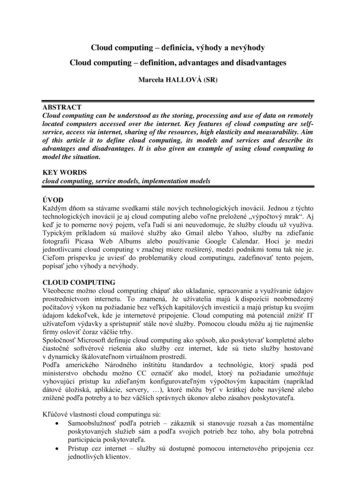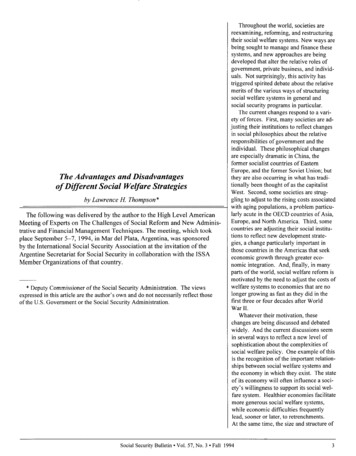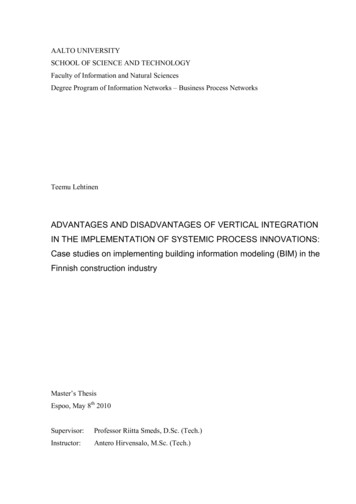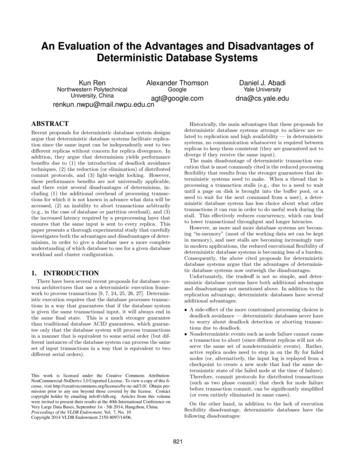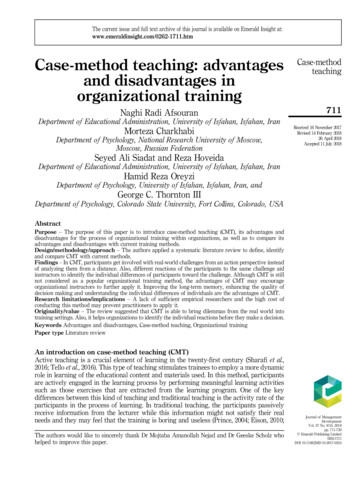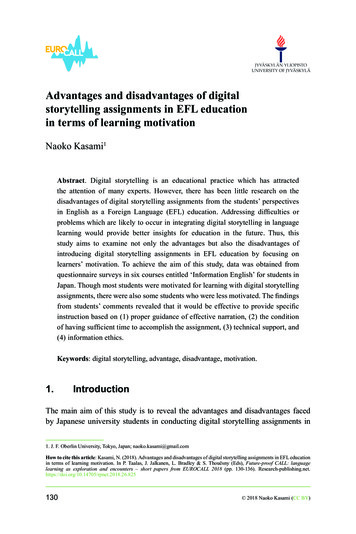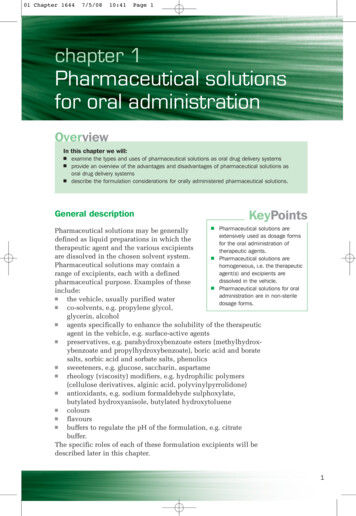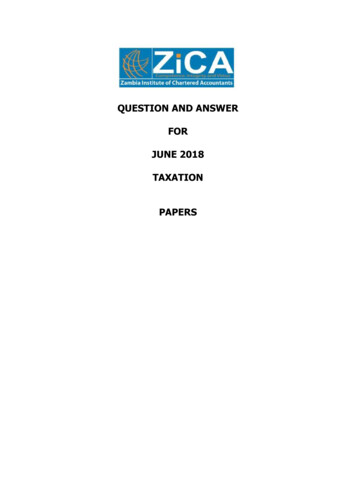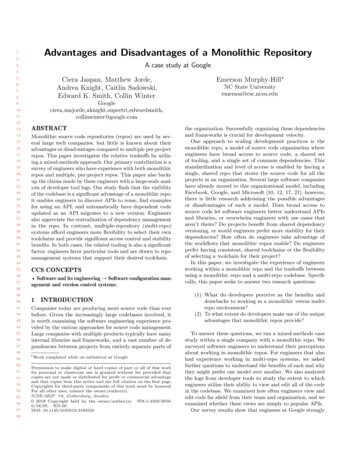
Transcription
Advantages and Disadvantages of a Monolithic Repository123A case study at Google45Ciera Jaspan, Matthew Jorde,Andrea Knight, Caitlin Sadowski,Edward K. Smith, Collin Winter6789111213ABSTRACT14Monolithic source code repositories (repos) are used by several large tech companies, but little is known about theiradvantages or disadvantages compared to multiple per-projectrepos. This paper investigates the relative tradeoffs by utilizing a mixed-methods approach. Our primary contribution is asurvey of engineers who have experience with both monolithicrepos and multiple, per-project repos. This paper also backsup the claims made by these engineers with a large-scale analysis of developer tool logs. Our study finds that the visibilityof the codebase is a significant advantage of a monolithic repo:it enables engineers to discover APIs to reuse, find examplesfor using an API, and automatically have dependent codeupdated as an API migrates to a new version. Engineersalso appreciate the centralization of dependency managementin the repo. In contrast, multiple-repository (multi-repo)systems afford engineers more flexibility to select their owntoolchains and provide significant access control and stabilitybenefits. In both cases, the related tooling is also a significantfactor; engineers favor particular tools and are drawn to repomanagement systems that support their desired 36373839CCS CONCEPTS Software and its engineering Software configuration management and version control systems;40141Companies today are producing more source code than everbefore. Given the increasingly large codebases involved, itis worth examining the software engineering experience provided by the various approaches for source code management.Large companies with multiple products typically have manyinternal libraries and frameworks, and a vast number of dependencies between projects from entirely separate parts of4243444546474849505152535455565758NC State om1015Emerson Murphy-Hill INTRODUCTIONWork completed while on sabbatical at GooglePermission to make digital or hard copies of part or all of this workfor personal or classroom use is granted without fee provided thatcopies are not made or distributed for profit or commercial advantageand that copies bear this notice and the full citation on the first page.Copyrights for third-party components of this work must be honored.For all other uses, contact the owner/author(s).ICSE-SEIP ’18, Gothenburg, Sweden 2018 Copyright held by the owner/author(s). 978-1-4503-56596/18/05. . . 15.00DOI: 10.1145/3183519.3183550the organization. Successfully organizing these dependenciesand frameworks is crucial for development velocity.One approach to scaling development practices is themonolithic repo, a model of source code organization whereengineers have broad access to source code, a shared setof tooling, and a single set of common dependencies. Thisstandardization and level of access is enabled by having asingle, shared repo that stores the source code for all theprojects in an organization. Several large software companieshave already moved to this organizational model, includingFacebook, Google, and Microsoft [10, 12, 17, 21]; however,there is little research addressing the possible advantagesor disadvantages of such a model. Does broad access tosource code let software engineers better understand APIsand libraries, or overwhelm engineers with use cases thataren’t theirs? Do projects benefit from shared dependencyversioning, or would engineers prefer more stability for theirdependencies? How often do engineers take advantage ofthe workflows that monolithic repos enable? Do engineersprefer having consistent, shared toolchains or the flexibilityof selecting a toolchain for their project?In this paper, we investigate the experience of engineersworking within a monolithic repo and the tradeoffs betweenusing a monolithic repo and a multi-repo codebase. Specifically, this paper seeks to answer two research questions:(1) What do developers perceive as the benefits anddrawbacks to working in a monolithic versus multirepo environment?(2) To what extent do developers make use of the uniqueadvantages that monolithic repos provide?To answer these questions, we ran a mixed-methods casestudy within a single company with a monolithic repo. Wesurveyed software engineers to understand their perceptionsabout working in monolithic repos. For engineers that alsohad experience working in multi-repo systems, we askedfurther questions to understand the benefits of each and whythey might prefer one model over another. We also analyzedthe logs from developer tools to study the extent to whichengineers utilize their ability to view and edit all of the codein the codebase. We examined how often engineers view andedit code far afield from their team and organization, and weexamined whether these views are simply to popular APIs.Our survey results show that engineers at Google strongly
ICSE-SEIP ’18, May 27-June 3, 2018, Gothenburg, 728293031prefer our monolithic repo, and that visibility of the codebase and simple dependency management were the primaryfactors for this preference. Engineers also cite as importantthe ability to find example uses of API and the ability toautomatically receive API updates. Logs data confirms thatengineers do take advantage of both the visibility of the codebase and the ability to edit code from other teams. Contraryto expectations, viewing popular APIs was not the primaryreason engineers view code outside of their team; this providesfurther [18] evidence that viewing code to find examples ofusing an API is important, possibly more so than viewingthe implementation of the API.We also discovered many interesting tradeoffs betweenusing monolithic and multi-repo codebases; they each hadbenefits that were not possible in the other system. Onesuch tradeoff was around dependencies. Engineers note thata primary benefit of multi-repo codebases is the ability tomaintain stable, versioned dependencies. This is particularlyinteresting because it is in direct contrast to two of the primary benefits of a monolithic repo: ease of both dependencymanagement and of receiving API updates. Another tradeoffappeared around flexibility of the toolchain. Engineers whoprefer multiple repos also prefer the freedom and flexibilityto select their own toolchain. Interestingly, the forced consistency of a monolithic repo was also cited as a benefit ofmonolithic repos.Finally, we saw evidence that for some engineers, the development tools were more important than the style of repo.Engineers called out favored development tools by name as areason to use one repo over another, even though in theory,these tools could be available for any type of repo.32333435362(1) Centralization: The codebase is contained in a singlerepo encompassing multiple projects.(2) Visibility: Code is viewable and searchable by allengineers in the organization.(3) Synchronization: The development process is trunkbased; engineers commit to the head of the repo.(4) Completeness: Any project in the repo can be builtonly from dependencies also checked into the repo.Dependencies are unversioned; projects must usewhatever version of their dependency is at the repohead.(5) Standardization: A shared set of tooling governs howengineers interact with the code, including building,testing, browsing, and reviewing code.3738394041424344454647484950515253MONOLITHIC REPOSITORIESFor purposes of this paper, we define a monolithic sourcerepo to have several properties:This definition is consistent with [21] and [29]. 1At the other extreme, a multi-repo system is one wherecode is separated by project. Notice that in a multi-repo54555657581Notice that there is a difference between a monolithic repo and a monolithic architecture. Linux is an example of a monolithic architecture,but it is not an example of a monolithic repo. Google’s codebase is theopposite; it is a monolithic codebase but not a monolithic architecture.C. Jaspan et al.system, it may still be true that code is viewable by allengineers, as is the case for open-source projects on GitHubor BitBucket. In theory, a multi-repo system could also havea shared set of developer tools; in practice this is rare asthere is no enforcement for this to happen across repos. In amulti-repo setup, commits are not to a single head, so versionskew and diamond dependencies (where each project maydepend on a different version of a library) do occur.At Google, almost all code exists in a single large, central repo, in which almost all code2 is visible to almost allengineers. The repo is used by over 20,000 engineers andcontains over 2 billion lines of code. All engineers that workin this monolithic repo use a shared set of tools, including asingle build system, common testing infrastructure, a singlecode browsing tool, a single code review tool, and a customsource control system. The build system depends on compilers that are also checked into the codebase; this allowsa centralized tooling team to update the compiler versionacross the company.While engineers can view and edit nearly the entire codebase, all code is committed only after the approval of a codeowner. Code ownership is path-based, and directory ownersimplicitly own all subdirectories as well. Engineers are limitedto using a small set of programming languages, and there isa tool-enforced style for each language.3METHODOLOGYTo understand how engineers perceive the advantages anddisadvantages of a monolithic repo, we surveyed a sample ofengineers at Google. Rather than only measuring engineersatisfaction with the monolithic repo, we asked them tocompare Google’s monolithic repo to their prior experienceswith other repo systems and to one hypothetical example.The goal was to identify the relative tradeoffs between amonolithic repo and multi-repos.We also took advantage of our ability to log engineers’interactions with the codebase. Our common developer toolsallow us to instrument not only commits to the codebase,but also file views. We used these logs to confirm some of thesurvey responses by showing that engineers not only say theytake advantage of the visibility they get from a monolithicrepo, but actively utilize this benefit.3.1AssumptionsWe had several assumptions based on prior internal surveysand interviews about developer tools.First, we expected our developer tools to be a major contributor to why engineers prefer our codebase. The internaltools regularly receive exceptionally high satisfaction ratingsin surveys and interviews. This is a potential source of bias ifwe ask about satisfaction with our codebase, and we wishedto separate satisfaction with the tools from satisfaction withthe general concept of a monolithic repo. To mitigate this,we asked a question in the survey that attempts to hold thedeveloper tooling stable for a comparison.2The primary exceptions are Chrome and Android.
Advantages and Disadvantages of a Monolithic Repository1234567891011121314151617Second, we expected visibility to be highly important toengineers. Engineers anecdotally cite it as a major factor fordevelopment velocity. However, we were uncertain whetherengineers actually take advantage of this power. Do engineerssay that visibility is important because they like the ideaof being able to view code in another project, or do theyactually utilize this ability on a regular basis? Because ofthis assumption, we planned our logs analysis to investigatethis further and mitigate this risk. Additionally, in our survey, we compare monolithic repos against open-source repos.Open-source repos like GitHub are also multi-repo codebases,but with full visibility, and so provide for a useful point ofreference beyond visibility benefits.Finally, we expected complexity to be a theme. Prior internal surveys had shown that the size and complexity of thecodebase overwhelms engineers. However, we were not surehow this complaint stacks up against potential benefits.ICSE-SEIP ’18, May 27-June 3, 2018, Gothenburg, Swedencoming to a shared agreement. In some cases, we split tags andretagged responses to tease apart emergent themes. Finally,we did keyword searches to verify tagged responses. We usedthe 21 tags to create frequency graphs and narratives aroundfive emergent themes (Section 5).3.3For our logs analysis, we sought to understand the extentto which engineers view and commit files outside of theirproject. As a project might be defined in different ways, wechose instead to focus at the level of a Product Area (PA).As there are only 12 PAs at the company, any view or editsthat are to the code of a different PA are highly likely to beoutside of an engineer’s project. This provides us with a lowerbound for the amount of cross-project views and commits.We analyzed two types of logs: Code browsing logs. Engineers at the company use aweb-based tool to browse code. The code browsingtool logs every time an engineer views a file. Whileengineers can still browse code within their editor,this practice is less common, as local editors have understandable difficulty indexing and searching crossreferences across a repo of this size. Code commit logs. This is simply the code that wascommitted into the codebase by an 839404142434445464748495051525354555657583.2Survey MethodologyWe randomly selected 1902 engineers who had worked atGoogle for at least three months, who had committed codeto our monolithic repo in the six months prior, and whohad averaged at least five hours a week in our developertools. The population for this sample was 23,000 softwareengineers at Google. We constructed our survey invitationto maximize survey responses using existing best practicesfrom the SE research community [26]. Engineers who hadnot completed their survey in the first 24 hours receivedan email reminder. None of the questions were required tocomplete the survey. Responses were confidential to the authors, but not anonymous. We also provided no incentivesfor survey completion. Of the 1902 engineers in the sample,869 completed the survey, yielding a response rate of 46%.Table 1 lists the survey questions, which were presentedin three blocks. The first block was shown to all participants. It asks about the engineer’s overall satisfaction withour monolithic codebase, their beliefs about how it impactsvelocity and quality3 , and their past experience with othercodebases. The second block of questions was only asked if theparticipant indicated that they had commercial experiencewith a multi-repo codebase, and the third block was onlyasked if the participant indicated experience in working onan open-source project.The survey utilized several free-response questions to capture each participant’s points of comparison and their motivation(s) for preferences. We employed an open codingmethodology to categorize responses. Responses could receive multiple tags; the full list we used is described in [14].We did a pass for common responses and tagged them (e.g.,responses consisting entirely of the name of the internal codebrowsing tool were tagged “visibility” and “developer tools”).We tagged the remainder collaboratively with three authors.We resolved disagreements by re-reading the response andTo investigate the percentage of actions (views and commits) on code outside of an engineer’s PA, we needed amapping from engineer to PA, and from source file to PA.Each of the approximately 28,000 engineers4 is assigned toone of 12 PAs for every week in our one-year study period.To map from source file to PA, we used project metadatafiles. These files specify, for each project, the code directoriesthey own and the PA the project belongs to. Code directoriesare not uniquely owned by a PA, and some directories arenot owned by any PA. In the case that multiple projectsclaim ownership, we selected the majority PA. 53% of codedirectories were assigned a PA; 47% were unassigned eitherdue no ownership or a tie for majority ownership.For the remaining 47% with no clear owning PA, we lookedat reviewers for commits in the directory. All code withinour company must be reviewed by an engineer who ownsthat code, so reviewers give a good approximation of codeownership. For each source code directory, we compiled thelist of reviewers who approved changes that were committed to that directory. We then looked up the PA for thosereviewers and selected the majority PA of the reviewers forthat directory. Majority PA is chosen because code often hasnon-owner reviewers from other PAs (e.g., subject-matterexperts, language approvers, etc.) From this, we were able toassign PAs to 93% of directories.The remaining 7% are directories where the code has noassigned project metadata and also has not been reviewed43The survey does not define the terms “velocity” or “code quality”,but these are commonly used terms within Google and engineers havedeveloped shared meaning around them.Logs analysis methodologyWe only considered full-time employees with job categories that signalthat software engineering is their primary task. This includes softwareengineers and related job categories, but not job categories such asmanagers, UI designers, or quantitative analysts.
ICSE-SEIP ’18, May 27-June 3, 2018, Gothenburg, SwedenC. Jaspan et al.1NumTextResponse type2Q1.1Rate your satisfaction with Google’s codebase as a software engineer.Q1.2Please rate how important the following are to your velocity as adeveloper. I can edit source code from almost any project at Google I can search almost all of Google’s source code7 point scale, “Extremely satisfied” to “Extremely dissatisfied”5 point scale, “Extremely important” to“Not at all important”Q1.3Please rate how important the following are to your code quality as adeveloper. I can edit source code from almost any project at Google I can search almost all of Google’s source code5 point scale, “Extremely important” to“Not at all important”Q1.4Tell us more about your background: Which of the following scenarioshave you experienced as a software engineer? Select all that apply, theydo not need to relate to your Google employment.Multi-select Collaborating as an individual onopen-source projects Working at a small company withfewer than 5 software engineers Working at a startup or a newproject where you started the codebase from scratch Working at a company with lots ofengineers, who have multiple coderepos Working at a company other thanGoogle, who has a large monolithiccodebaseQ2.1Think back to your experience with the last multi-repo codebase youused. Rate your satisfaction with that codebase as a software engineer.Comparing your experience with the most recent multi-repo codebaseyou used to working in Google’s codebase, which codebase did youprefer?Why? Describe what motivates your preference.What are some of the benefits you found to working in a multi-repocodebase?What are some of the benefits you found to working in Google’s singlerepo codebase?If you could choose to work with Google’s codebase as a monolithicrepo or in multiple smaller repos, which would you choose?7 point scale, “Extremely satisfied” to “Extremely dissatisfied”7 point scale, “Strongly prefer multi-repocodebase” to “Strongly prefer Google’scodebase ”Free responseFree responseWhat is the single main reason you would choose to use Google’scodebase (as a single repo/in multiple smaller repos)?Comparing your experience with your most recent open-source projectto working in Google’s codebase, which codebase did you prefer?Free 243444546Free responseSingle select I would prefer toGoogle’s codebase in I would prefer toGoogle’s codebasesmaller repos No preferencework witha single repowork within multiple4748Q2.74950Q3.1515253Single select My open-source project codebase Google’s codebase Neither5455Q3.2565758Q3.3What are some of the benefits you found to working in open-source Free responsecodebases?What are some of the benefits you found to working in Google’s code- Free responsebase?Table 1: Survey questions
Advantages and Disadvantages of a Monolithic Repository1234567ICSE-SEIP ’18, May 27-June 3, 2018, Gothenburg, Sweden(and thus not modified) in over a year. We excluded thesecode directories from our analysis.To analyze the extent of views/commits that occur crossPA, we calculated the percentage of an engineer’s interactionswith files in a different PA for each week in 2016. We thenaveraged each engineer’s percentage across all weeks. Finally,we computed distribution statistics across all engineers.79%!17%!26%!33%!19%!17%!5%!3%!8I can edit source code from almostany project at our company!910113.412Our survey may suffer from selection bias; software engineers’codebase preferences may impact where they work, such thatthose who prefer multi-repo codebases may choose to workat a company with such a codebase. Other companies couldrerun our survey to determine whether their workforce preferstheir respective codebase model. Our survey may also sufferfrom nonresponse bias, though we acheived a good responserate of 46%.Our survey results may have a major confounding factorfrom Google’s internal developer tools. Engineers may haverated the monolithic codebase highly when, in fact, it was thedeveloper tools that they had a strong preference for. Indeed,the developer tools did come up as a major benefit, thoughcertainly not the only one. To mitigate this confound, Q2.6and Q2.7 ask about whether particpants had a preference forGoogle’s codebase in a monolithic repo or a (hypothetical)multi-repo codebase where tooling could be considered tobe equal. This appears to be a successful mitigation; fewerrespondents cited developer tools in these questions comparedto Q2.2 and Q2.3.Our survey results may also suffer from priming. In particular, Q1.2 and Q1.3 ask the participant to think about therelationship between their ability to see and edit the entirecodebase with velocity and code quality. It is likely thatthis primed participants later to think about the visibilityof a codebase, velocity, and code quality when consideringpotential benefits to different types of code repos.We used an open-coding methodology to classify developersurvey responses into thematic areas. This process is inherently subjective. We used a collaborative open-coding processwith three coders to ensure no single coder had unmitigatedinfluence over the coding. We do not claim this to be acomplete or singular way of coding this data.The primary threat to validity for the quantitative logsanalysis is the heuristic for assigning source code to a PA.53% of the code directories were mapped to a PA usingmetadata files. These metadata files may be inaccurate if aproject moves from one PA to another PA, though this israre. If this happens, we would have swapped whether theproject was within an engineer’s PA or outside of it. We alsocould not calculate a PA for the 7% of directories which hadno metadata file and no commits in the last year. However,it is likely that these are dead projects. Finally, we assignonly a single PA to each directory. 3.9% of directories areclaimed by multiple PAs. 13.6% of users had at least oneinteraction matching a file’s minority PA (a potential eats to ValidityExtremely important!Very important!1%!0%!I can search across our company'ssource code!Moderately important!Slightly important!Not at all important!Figure 1: Impact on velocity. (Q1.2)67%!30%!12%!17%!25%!I can edit source code from almostany project at our company!Extremely important!22%!16%!Very important!8%!2%!0%!I can search across our company'ssource code!Moderately important!Slightly important!Not at all important!Figure 2: Impact on code quality. (Q1.3)positive). However, the impact was small; only 6 engineershad 1% or more of their interactions affected.4RESULTSOf the 869 engineers who completed the survey: 455 (52%) had prior experience where they starteda codebase from scratch. 379 (44%) had prior experience in a corporate multirepo codebase. 337 (39%) had prior experience using open-sourcecodebases. 321 (37%) had prior experience working at a companywith fewer than 5 software engineers. 205 (24%) had prior experience using a monolithiccodebase at a different company.Survey questions Q1.2 and Q1.3 asked all 869 engineers toevaluate how their ability to search/edit code impacted theirvelocity and code quality. Figures 1 and 2 show the results forthese questions. Participants overwhelmingly reported thatthe ability to search code is important to both velocity andcode quality. Participants had mixed opinions on whetherthe ability to edit code across the codebase is important tovelocity and code quality.The logs analysis confirmed that engineers regularly viewcode outside of their PA. The first two rows of Table 2 show
ICSE-SEIP ’18, May 27-June 3, 2018, Gothenburg, Sweden1234C. Jaspan et al.InteractionCode viewCode commitCode 75%99th%94%100%92%Code commitCode Code ommon filesCommon files and lowactivity engineersTable 2: Percentage of cross-PA interactions for engineers.111213141516 The median code view value of 28% indicates that for50% of engineers, over 28% of file views are outsideof the author’s PA. The 90th percentile code commit value of 60% meansthat for 10% of engineers, over 60% of their commitsare outside of their PA.171819202122232425262728293031As engineers at our company, we were surprised by howmuch cross-PA activity actually occurs in practice. We hypothesized that many of the code views may be coming fromengineers viewing the APIs of common libraries, includingcore libraries like collections, distributed databases, and distributed computing frameworks [5, 6, 11]. To account for this,we compiled a set of files to be excluded from analysis dueto their common nature:32 A hand-curated list of 26 very common directoryprefixes (including projects like Guava [11]) All directories that had more than 10,000 cross-PAcode views in 2016. This constitutes 63,500 sourcecode directories out of 1,817,000 (3.5%). All build configuration files, as these may be lookedat to see what code is available for reuse. All interface files for service-level APIs [22].333435363738394041424344454647484950The second two rows of Table 2 exclude the files describedabove from the analysis. Despite these exclusions, there isonly a minor change in the distributions. This signals thatmost of the cross-PA views are not for common libraries.We also examined the people who only commited codeoutside of their PA. Most of these came from engineers whohad not contributed much code at all. The last two rowsof Table 2 exclude both common files and engineers whoauthored fewer than 20 commits in 2016.5 This had the effectof removing outliers at both ends of the distribution.515253545556575857%the percentage of cross-PA interactions for engineers. Forexample:5Why 20? We examined the number of commits for our 1902 surveyedengineers, all of whom had averaged at least 5 hours a week workingwithin our developer tools and had submitted code in the prior 6months. We found that all but 4 of the 1902 surveyed engineers hadmore than 20 CLs.26%24%17%9%2% 3% 1% 1%Satisfaction with our monolithiccodebaseExtremely satisfiedSlightly dissatisfiedModerately satisfiedModerately dissatisfied11% 13% 11%14%5%Satisfaction with previous multirepo codebaseSlightly satisfiedExtremely dissatisfiedNeutralFigure 3: Relative satisfaction ratings of engineers with commercial multi-repo experience. (Q1.1 and Q2.1)4.1Participants with corporate multi-repocodebase experience379 of the 869 participants reported experience working ata company that used multiple repos. Q2.1 asked these participants to rate their satisfaction with the latest such codebase, and Q1.1 asked participants for their satisfaction withGoogle’s codebase. Figure 3 compares the satisfaction ratesfor these 379 participants on these two questions. While satisfaction with Google’s codebase is high overall, satisfactionwith multi-repo codebases is mixed.The survey also explicitly asked these 379 participantswhich codebase they prefer (Q2.2) and why (Q2.3). 326 particpants preferred Google’s codebase, 22 prefered their mostrecent monolithic codebase, and 31 had no preference. Theauthors open-coded the responses for the 232 participantswho provided a reason for their preference, which resulted in544 codes (some responses received multiple codes). Figure4 shows the counts of reasons for their preference, split bywhich repo they preferred. The list of codes is in [14], andrelevant codes are discussed further in Section 5. The topreasons for preferring Google’s codebase centered aroundcode reuse, including the ability to see all the code andthe ease of dependency management. Since there were only22 participants who preferred their most recent multi-repoexperience, it is hard to infer many patterns. The primary
Advantages and Disadvantages of a Monolithic Repository123456789101112ICSE-SEIP ’18, May 27-June 3, 2018, Gothenburg, Sweden98!-1!Visibility of codebase!-2!Code Reuse!-2!Reduced cognitive load!-2!Dependency Mgmt!-1!Available Dev Tools!Easy Updates!Usage Examples!Velocity! nt Style!-6!Stability!Stable dependencies!None/Very Little!Build Time!Dependency Mgmt!Velocity!Small size!Quality!Freedom/Flexibility!Reduced cognitive lo
A case study at Google Ciera Jaspan, Matthew Jorde, Andrea Knight, Caitlin Sadowski, Edward K. Smith, Collin Winter . Advantages and Disadvantages of a Monolithic Repository ICSE-SEIP '18, May 27-June 3, 2018, Gothenburg, Sweden (andthusnotmodified)inoverayear.Weexcludedthese
